Accessibility to Cultural Tourism: The Case of the Major Museums in the City of Seville
Abstract
1. Introduction
- Fine Arts Museum
- Archeology Museum
- Popular Arts and Customs Museum
- Naval Museum (Torre del Oro)
- Military History Museum
- Antiquarian
- Andalusian Center of Contemporary Art
- House of Science
2. Review of the Scientific Literature and Contributions of the Work
3. Accessible Tourism
4. Evaluation of Museum Accessibility in the City of Seville
4.1. Seville under the Prism of Accessible Cultural Tourism
4.2. Empirical Work
4.2.1. Sample
4.2.2. Evaluation and Measurement Instrument
4.2.3. Analysis of the Results
- Group 1: Bellas Artes (Fine Arts Museum) and Casa de las Ciencia (House of Science).
- Group 2: Historia Militar (Military History Museum) and the Naval Museum (Torre del Oro).
- Group 3: Antiquarium, Arqueológico (Archeology Museum) and Arte y CostumbresPopulares (Popular Arts and Customs Museum).
- Group 4: Centro de Arte Contemporáneo (Center of Contemporary Art).
- Group 1: Bellas Artes (Fine Arts Museum) and Centro de Arte Contemporáneo (Center of Contemporary Art).
- Group 2: Historia Militar (Military History Museum) and the Naval Museum (Torre del Oro).
- Group3: Antiquarium, Arte y Costumbres Populares (Popular Arts and Customs Museum) and Casa de las Ciencias (House of Science).
- Group 4: Arqueológico (Archeology Museum).
- Group 1: Arte y Costumbres Populares (Popular Arts and Customs Museum) and the Naval Museum (Torre del Oro).
- Group 2: Historia Militar (Military History Museum).
- Group 3: Antiquarium, Bellas Artes (Fine Arts Museum) and Casa de las Ciencias (House of Science).
- Group 4: Arqueológico.
- Group 5: Centro de Arte Contemporáneo (Center of Contemporary Art).
- Group 1: Centro de Arte Contemporáneo (Center of Contemporary Art).
- Group 2: Casa de las Ciencias (House of Science).
- Group 3: Arte y Costumbres Populares (Popular Arts and Customs Museum), Naval Museum (Torre del Oro), Historia Militar (Military History Museum), Antiquarium, Arte y Costumbres Populares (Popular Arts and Customs Museum) and Bellas Artes (Fine Arts Museum).
- Group 1: Naval Museum (Torre del Oro) and Centro de Arte Contemporáneo (Center of Contemporary Art).
- Group 2: Historia Militar (Military History Museum).
- Group 3: Casa de las Ciencias (House of Science) and Arqueológico (Archeology Museum).
- Group 4: Arte y Costumbres Populares (Popular Arts and Customs Museum).
- Group 5: Antiquarium and Bellas Artes (Fine Arts Museum).
5. Discussion
6. Conclusions
Author Contributions
Funding
Institutional Review Board Statement
Informed Consent Statement
Data Availability Statement
Conflicts of Interest
References
- Buhalis, D.; Darcy, S. Accessible tourismConcepts and IssuesChannel View Publications: Bristol, UK, 2011; pp. 10–11.
- Devile, E. Turismo e Desenvolvimen to Sustentável; GEOTA—Grupode Estudosde Ordenamentodo Territórioe Ambiente: Lisboa, Portugal, 2007; Volume 2. [Google Scholar]
- World Bank. Available online: https://www.bancomundial.org/es/topic/disability (accessed on 3 April 2019).
- Buhalis, D.; Eichhorn, V.; Michopoulou, E.; Miller, G. Accessibility Market and Stakeholder Analysis. In OSSATE-One-Stop-Shop for Accessible Tourism in Europe; University of Surrey: Guildford, UK, 2005. [Google Scholar]
- UN. Available online: http://www.un.org/es (accessed on 9 December 2019).
- CNAD. Turismo Acessível, Turismo Para Todos: Guia De Referência Para Profissionais De Turismo—Um aResposta Às Necessidades Especiais Dos Turistas Com Deficiencia; Cooperativa Nacionale Apoio a Deficientes: Lisboa, Portugal, 2003. [Google Scholar]
- Lambin. Marketing Estratégico, 4th ed.; Mc Graw Hillde Portugal: Lisboa, Portugal, 2000. [Google Scholar]
- Espinosa, A.; Bonmatí Lledó, C. Accessibility, inclusión and design for all in museums and heritage. Her Mus. Herit. Mus. 2015, 7, 11–20. [Google Scholar]
- Garcés, A. Tipología del patrimonio y accesibilidad. In Proceedings of the Actas de las Jornadas de Accesibilidad UniversalalPatrimonio, Ávila, Spain, 26–28 November 2008; pp. 41–56. [Google Scholar]
- Meor, F. Rehabilitación del Patrimonio y Accesibilidad. Jornadas de Accesibilidad Universalal Patrimonio. Actas del congreso Concejalía de Accesibilidad. Excmo. Ayunt. Ávila España 2008, 1, 33–40. [Google Scholar]
- Dickinson, J.E.; Robbins, D.; KFletcher, J. Representation of transport—Arural destination analysis. Ann. Tour. Res. 2009, 36, 103–123. [Google Scholar] [CrossRef]
- Gossling, S.; Hall, C.M. Tourism and global environmental change: Ecological, social, economic and political interrelationships. Taylor Fr. 2006, 4, 323. [Google Scholar]
- Lumsdon, L.; Page, S.J. Tourism and Transport: Issues and Agenda for the New Millennium; Elsevier: Oxford, UK, 2004; p. 180. [Google Scholar]
- Sharpley, R. Travel and Tourism; Canterbury SAGE Course Companions; SAGE: Thousand Oaks, CA, USA, 2006; p. 232. [Google Scholar] [CrossRef]
- Daniels, M.J.; Rodgers, E.B.; Wiggins, B.P. “TravelTales”: An interpretive analysis of constraints and negotiations to pleasure travelas experienced by persons with disabilities. Tour. Manag. 2005, 26, 919–930. [Google Scholar] [CrossRef]
- Nyaupane, G.P.; Andereck, K.L. Understanding travel constraints: Application and extension of a leisure constraints model. J. Travel Res. 2008, 46, 433–439. [Google Scholar] [CrossRef]
- Shaw, G. Disability legislation and empowerment of tourists with disability in the United Kingdom. In Tourism, Power and Space; Church, A., Coles, T., Eds.; Routledge: London, UK, 2007; pp. 83–100. [Google Scholar]
- Veitch, C.; Shaw, G. Disability legislation and empowerment of tourists with disability: The UK case. In Accessible Tourism: Concept and Issues; Buhalis, D., Darcy, Eds.; Channel View Publications: Bristol, UK, 2011; pp. 62–72. [Google Scholar]
- Freeman, I.; Selmi, N. French versus Canadian tourism: Response to the disabled. J. Travel Res. 2010, 49, 471–485. [Google Scholar] [CrossRef]
- Darcy, S.; Cameron, B.; Pegg, S. Accessible tourism and sustainability: A discussion and case study. J. Sustain. Tour. 2010, 18, 515–537. [Google Scholar] [CrossRef]
- Burns, N.; Paterson, K.; Watson, N. An inclusive outdoors? Disabled people’s experiences of country side leisure services. Leis. Stud. 2009, 28, 403–417. [Google Scholar] [CrossRef]
- Uchiyama, Y.; Kohsaka, R. Cognitiv evalue of tourism resources and their relationship with accessibility: Acase of Notoregion, Japan. Tour. Manag. Perspect. 2016, 19, 61–68. [Google Scholar] [CrossRef]
- Figueiredo, E.; Eusébio, C.; Kastenholz, E. How diverse are tourists with disabilities? A pilot study on accessible leisure tourism expériences in Portugal. Int. J. Tour. Res. 2012, 14, 531–550. [Google Scholar] [CrossRef]
- Bi, Y.; Jaclyn, A.; Shu, T.C. Accessibility and attitudinal barriers encountered by Chinese travelers with physical disabilities. Int. J. Tour. Res. 2007, 9, 205–216. [Google Scholar] [CrossRef]
- Murray, M.; Sproats, J. The disabled traveler: Tourism and disability in Australia. J. Tour. Stud. 1988, 1, 9–14. [Google Scholar]
- Fernández-Villarán, A. Turismo Accesible: Análisis de la Accesibilidad Hotelera en la Provincia de Cádiz. Ph.D. Thesis, Universidadde Cádiz, Cádiz, Spain, 2007. [Google Scholar]
- Geurs, K.T.; Van Wee, B.; Rietveld, P. Accessibility appraisal of integrated land-use transport strategies: Methodology and case study for the Netherlands Randstadarea. Environ. Plan. 2006, 33, 639–660. [Google Scholar] [CrossRef]
- Friedner, M.; Osborne, J. New Disability Mobilities and Accessibilities in Urban India. City Soc. 2015, 27, 9–29. [Google Scholar] [CrossRef]
- Guillén., L.; García, A.R. Valoración dela infraestructura de los edificios religiosos para el turismo accesible en Villahermosa, Tabasco, México.PASOS. Rev. Tur. Patrim. Cult. 2015, 13, 491–508. [Google Scholar] [CrossRef]
- Okerlund, J.; Segreto, E.; Grote, C.; Westendorf, L.; Scholze, A.; Littrell, R.; Shaer, O. Synflo: A Tangible Museum Exhibit forExploring Bio-Design. In Proceedings of the TEI ‘16: Tenth International Conference on Tangible, Embedded, and Embodied Interaction 2016, New York, NY, USA, 14–17 February 2016; pp. 141–149. [Google Scholar]
- Pereira, P. Os Dispositivos Móveis No Apoio a Visitas a Museus: Um Estudo D aParticipação Através Dos Dispositivos Móveis No Apoio à Informação E Comunicação Em Visitas a Museus. Ph.D. Thesis, Aveiro Universityand Porto University, Aveiro, Portugal, 2013. [Google Scholar]
- Chelini, M. Nova stecnologias para … novas (?) expografias. Rev. Museol. Interdiscip. 2012, 12, 59–71. [Google Scholar]
- Kidd, J.; Ntalla, I.; Lyons, W. Multi-touch interfaces in museum spaces: Reporting preliminary findings on the nature of interaction. In Re-Thinking Technology in Museums: Emerging Experiences; Ciolfi, L., Scott, K., Barbieri, S., Eds.; University of Limerick: London, UK, 2011. [Google Scholar]
- Vom Lehn, D. Embodying experience. A video-based examination of visitors’conduct and interaction in museums. Eur. J. Mark. 2006, 40, 1340–1359. [Google Scholar] [CrossRef]
- Kabassi, K. Evaluating websites of museums: Stateoftheart. J. Cult. Herit. 2017, 24, 184–196. [Google Scholar] [CrossRef]
- Pallud, J.; Straub, D.W. Effective website design for experience-influenced environments: The case of high culture museums. Inf. Manag. 2014, 51, 359–373. [Google Scholar] [CrossRef]
- Theocharidis, A.I.; Nerantzaki, D.M.; Vrana, V.; Paschaloudis, D. Use of the band social media by Greek museums. Int. J. Cult. Digit. Tour. 2014, 1, 8–22. [Google Scholar]
- Yuquan, S. The accessibility of Queensland visitor information centres’ websites. Tour. Manag. 2006, 27, 829–841. [Google Scholar]
- Walters, D. Approaches in museums towards is ability in the United King domand the United State. J. Mus. Manag. Curatorship 2008, 24, 29–46. [Google Scholar] [CrossRef]
- Dong, P.; Yee-Man Siu, N. Services cape elements, customer predispositions and service experience: The case of the me park visitors. Tour. Manag. 2013, 36, 541–551. [Google Scholar] [CrossRef]
- AEVAL. Agencia Estatal de Evaluación de las Políticas Públicas y la Calidad de los Servicios. Evaluación de la Calidad del Servicio de los Museos de Titularidad Estatal. 2007. Available online: https://www.mptfp.gob.es/dam/es/portal/funcionpublica/evaluacion-politicas-publicas/Documentos/Evaluaciones/2007/E08.pdf (accessed on 15 February 2021).
- Generalitat of Catalunya. Catalunya per a un Turisme Accesible. Turisme pera Tothom. Turisme de Catalunya. 2007. Available online: http://www.turismeperatothom.com/ (accessed on 15 February 2021).
- Prieto, B.; García, A. Tourist accessibility in Oviedo. Fine Arts Museum of Asturias. Rev. Astur. Ter. Ocup. 2011, 9, 24–30. [Google Scholar]
- Reich, C.; Lindgren-Streicher, A.; Beyer, M.; Levent, N.; Pursley, P.; Mesiti, L.A.; Speaking Out on Art and Museums: A Study on the Needsand Preferences of Adults Who Are Blind or Have Low Vision. Museum of Science, Boston and Art beyond Sight 2011. Available online: http://www.artbeyondsight.org/new/speaking-out-on-art-and-museums.shtml (accessed on 15 February 2021).
- Fernández Alles, M.T. Los museos accesibles en España: El caso Guggenheim. Rev. Tur. Y Patrim. Cult. 2013, 11, 399–415. [Google Scholar] [CrossRef]
- Pérez-Alcaide Morales, O.; Museums for those Who Feel: Accessibility in Spanish Museums. The Case of the Museum of Natureand Man, Santa Cruz de Tenerife. 2014. Available online: https://riull.ull.es/xmlui/handle/915/1223 (accessed on 15 February 2021).
- Urpí, C.; Garro, N.; Domeño, A. Accesibilidad enel Museo Universidad de Navarra Como Lugar Relacional Para Una Educación Flexible 2014. Available online: https://www.researchgate.net/publication/293781615_Accesibilidad_en_el_Museo_Universidad_de_Navarra_como_lugar_relacional_para_una_educacion_flexible (accessed on 15 February 2021).
- Martínez Carrillo, M.J. Análisis del grado de accesibilidad universal del Museo de Historia Natural de Rouen (Francia). Turydes: Rev. Sobre Tur. Y Desarro. Local Sosten. 2018, 11, 15. [Google Scholar]
- Molina Hoyo, M. Del Turismo Accesibleal Museo Inclusive: Un Modelo Parala Evaluación de la Accesibilidad UniversalenlosMuseos. El caso del COSMOCAIXA en Barcelona. Ph.D. Thesis, Universidad Autónoma de Barcelona, Barcelona, Spain, 2019. [Google Scholar]
- Villarín Díaz, P. Estudio de las Condiciones Técnicas Para la Adaptación a la Normativa de Accesibilidad del Colegio e Iglesia Santa Isabel. Proyecto Fin de Grado 2019; Universidad de Sevilla: Sevilla, Spain, 2019. [Google Scholar]
- Flores Roncero, J. Turismo Accesible Desde el Punto de Vista de la Discapacidad Visual. Proyecto Fin de Grado 2020; Universidad de Sevilla: Sevilla, Spain, 2020. [Google Scholar]
- Martínez Carrillo, M.J. Museums accessible to everyone. Diagnosis of the universal accessibility of the Caen museums (France). Rev. Int. Tur. Empresa Y Territ. 2020, 8, 128–157. [Google Scholar]
- Pablos, L.; Fontal, O. Accessibility in Spanish Museums: Evaluation of Heritage Education Programs for People with ASD; Educatio Siglo XXI; RIDE Revista Iberoamericana Para La Investigación Y El Desarrollo Educativo: Sevilla, Spain, 2020; pp. 99–118. [Google Scholar] [CrossRef]
- Michopoulou, E.; Darcy, S.; Ambrose, I.; Buhalis, D. Accessible tourism futures: The world we dream to live in and the opportunitie we hope to have. J. Tour. Futures 2015, 1, 179–188. [Google Scholar] [CrossRef]
- Ambrose, I. Best Practice in Accessible Tourism: Inclusion, Disability, Aging Population and Tourism; Channel View Publications: Bristol, UK, 2012. [Google Scholar]
- Darcy, S.; Cameron, B.; Schweinsberg, S. Accessible tourism in Australia. In Best Practice in Accessible Tourism: Inclusion, Disability, Aging Population and Tourism; Buhalis, D., Darcy, S., Ambrose, I., Eds.; Channel View Publications: Bristol, UK, 2012; pp. 79–113. [Google Scholar]
- Law N°25. Available online: https://www.argentina.gob.ar/justicia/derechofacil/leysimple/turismo-accesible (accessed on 2 May 2019).
- Dominguez, T.; Darcy, S.; Gonzalez, E. Competing for the disability tourism market—A comparative exploration of the factors of accessible tourism competitiveness in Spain and Australia. Tour. Manag. 2015, 47, 261–272. [Google Scholar] [CrossRef]
- Kastenholz, E.; Eusébio, C.; Figueiredo, E.; Lima, J. Accessibility as competitive advantage of a tourism destination: The case of lousã. In Field Guide to Case Study Research in Tourism, Hospitality and Leisure (Advances in Culture, Tourism and Hospitality Research; Hyde, K.F., Ryan, C., Woodside, A.G., Eds.; Emerald Group Publishing Limited: Bingley, UK, 2012; Volume 6, pp. 369–385. [Google Scholar]
- Medeiros Barbosa, L.G. Midi en dola competitividaden los destinos: El modelo brasilero. El conocimiento como valor diferencial de los destinos turísticos. In Proceedings of the Exposiciónl Levada Acaboen la Conferencia Internacional de Turismo, Málaga, Spain, 29–31 October 2008. [Google Scholar]
- Porto, N.; Rucci, A.C. Accessibility in tourism: Diagnosis, political will and actions. Estud. Perspect. Tur. 2018, in press. [Google Scholar]
- Porto, N.; Rucci, A.C.; Ciaschi, M. Tourism & accessibility in the world heritages it e sof Latin America. In Proceedings of the Lannual Meeting of the Argentine Association of Political Economy, Tucumán, Argentina, 2–6 January 2016. [Google Scholar]
- Porto, N.; Rucci, A.C.; Ciaschi, M. Tourism specialization and accessibility in world heritagesites of MERCOSUR. Transitare 2017, 3, 1–31. [Google Scholar]
- Rucci, A.C. Discapacida Denel MERCOSUR: Accesibilidad Turística Como una Propuesta de Desarrollo Regional. Master’s Thesis, University of La Plata, La Plata, Argentina, 2018. [Google Scholar]
- OMT. Manual Sobre Turismo Accesible Para Todos: Principios, Herramientas y Buenas Prácticas. Módulo I: Turismo Accesible –Definición y Contexto; OMTyENAT; Fundación ONCE: Madrid, Spain, 2015. [Google Scholar]
- Porto, N.; Rucci, A.; Clarab, D.S.; Garbero, N.; Almond, B. Critical elements in accessible tourism for destination competitiveness and comparison: Principal component analysis from Oceania and South America. Tour. Manag. 2019, 75, 169–185. [Google Scholar]
- OMS. Available online: https://www.who.int/es/news-room/facts-in-pictures/detail/disabilities (accessed on 1 December 2020).
- INE. Españaen Cifras 2015. Available online: Ine.es/prodyser/espa_cifras/2015 (accessed on 21 October 2019).
- Darcy, S. Inherent complexity: Disability, accessible tourism and accommodation information preferences. Tour. Manag. 2010, 31, 816–826. [Google Scholar] [CrossRef]
- OMT. Available online: https://www.who.int/features/factfiles/disability/es/ (accessed on 11 August 2019).
- Hernández-Galán, J.; Dela Fuente Robles, Y.M.; Campo Blanco, M. La accesibilidad universal y el diseño para todas las personas factor clave para la inclusiónocial des del design thinking curricular” Educación Social. Rev. Interv. Socioeducativa 2014, 58, 119–134. [Google Scholar]
- Brinckmann, W.; Wildgen, J. Desafíos para los estudiosos del turismo: La construcción de la“sociedad inclusiva”y del“turismo accesible”. Cuad. Tur. 2003, 11, 41–58. [Google Scholar]
- Sua, Y.; Teng, W. Contemplating museums’s ervice failure: Extracting the service quality dimensions of museums from negativeon-linereviews. Tour. Manag. 2018, 69, 214–222. [Google Scholar] [CrossRef]
- Consorcio de Turismo de Sevilla. Balanceanual de 2018 del Turismo de Sevilla. In Proceedings of the Indicadores Turísticos de la Ciudad de Sevilla, Ayuntamientode Sevilla, Sevilla, Spain, 28 February 2018. [Google Scholar]
- Casado, M. Reactivación de Destinos Maduros a Través del Turismo Accesible: Caso Práctico de Sevilla. Trabajo Fin de Grado. 2014, Grado en Turismo; Universidad de Sevilla: Sevilla, Spain, 2014. [Google Scholar]
- ONU. Convención Sobre los Derechos de las Personas con Discapacidad. Oficina del Alto Comisariado Para los Derechos Humanos; Seriede Capacitación Profesiona lN°15; Naciones Unidas: Nueva York, NY, USA, 2008. [Google Scholar]
- AENOR. UNE 170001-1: Accesibilidad Universal. Parte 1—Criterios DALCO Para Facilitar la Accesibilidad al Entorno; Asociación Española de Normalización: Madrid, Spain, 2007. [Google Scholar]
- AENOR. UNE 170001-2: Accesibilidad Universal. Sistema de Gestión de la Accesibilidad; Asociación Española de Normalización: Madrid, Spain, 2009. [Google Scholar]
- Greenacre, M.; Blasius, J. Multiple Correspondence Analysis and Related Methods; Chapman & Hall/CRC: London, UK, 2006. [Google Scholar]
- Greenacre, M. Correspondence Analysis in Practice, 2nd ed.; Chapman & Hall/CRC: London, UK, 2007. [Google Scholar]
- Abuín, F.; Aedo, J.L.; Azcona Antón, M.; Barreiro, C.; Belinchón, M.; Bonmatí Lledó, C.; Consuegra Cano, B.; Espinosa Ruiz, A.; Ferro, A.; Fiallega, S.; et al. Museo e Inclusión social. In Revista del Comité Español de; ICOM (International Council of Museums): Paris, France, 2011. [Google Scholar]
- Zúñiga Robles, L. Manual de Accesibilidad Para Museos; Museo de Arte de Lima: Lima, Peru, 2019. [Google Scholar]
- Hermida, S. Guíade Turismo Accesible Familiar. 2019. Available online: https://soniahermida.com/turismo-accesible-familiar (accessed on 12 March 2021).
- Hernández-Galán, J.; Borau Jordán, J.L.; Sánchez Martín, C.; Martorell Martínez, V.; Medina Higueras, M.; Carmona Rojo, I.; López Gómez, R.; Almonacid Ramos, J.C.; Barragán Iturriaga, A.; Bascones, L.M.; et al. Observatorio de Accesibilidad Universal del Turismo en España, 1st ed.; Fundación ONCE: Madrid, Spain, 2017. [Google Scholar]
- WCED. Our Common Future; Report of the World Commission on Environment and Development; Oxford University Press: Oxford, UK, 1987. [Google Scholar]
- López, I.; Arriaga, A.; Pardo, M. Ladimensión social del concepto dedesarrollo sostenible: La eterna olvidada? Rev. Española Sociol. 2018, 27, 25–41. [Google Scholar]
- UN. Objetivos de Desarrollo Sostenible; Naciones Unidas: New York, NY, USA, 2015; Available online: https://www.undp.org/content/undp/es/home/sustainable-development-goals (accessed on 3 March 2021).
- CERMI. Objetivos de Desarrollo Sostenible y Promoción de los Derechos de las Personas con Discapacidad; Grupoeditorial Cinca, SA; CERMI: Madrid, Spain, 2019. [Google Scholar]
- Aguilera, A.; Puerto, D.P. Crecimiento empresari albasadoenla Responsabilidad Social. Pensam. Gestión 2012, 32, 3. [Google Scholar]
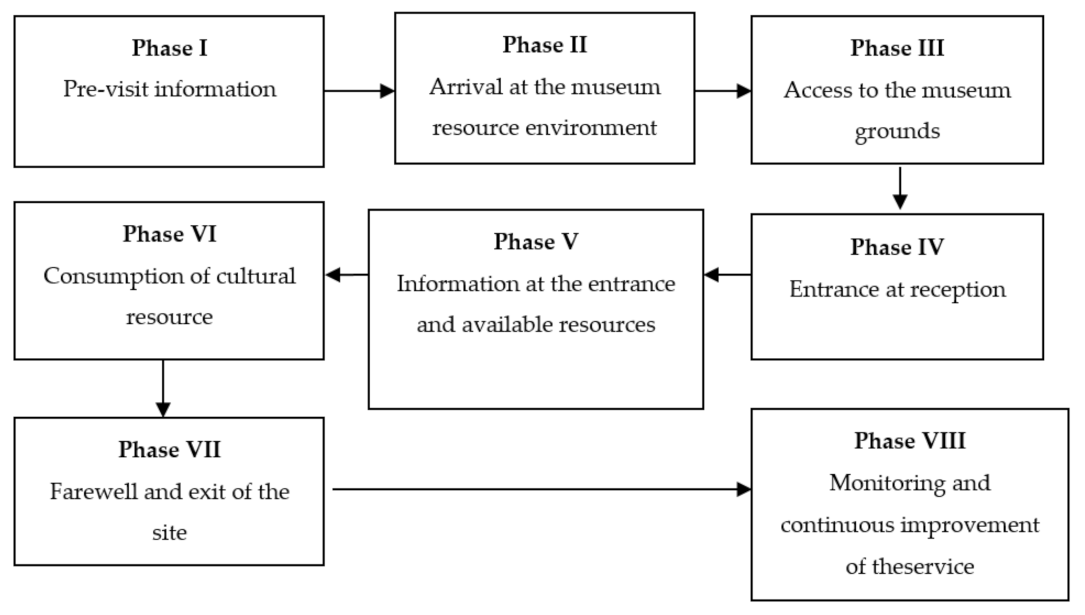
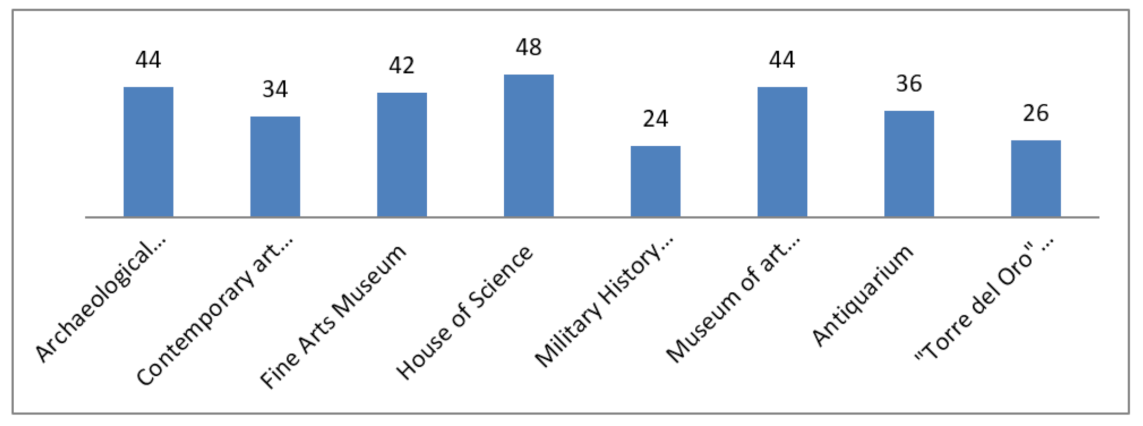
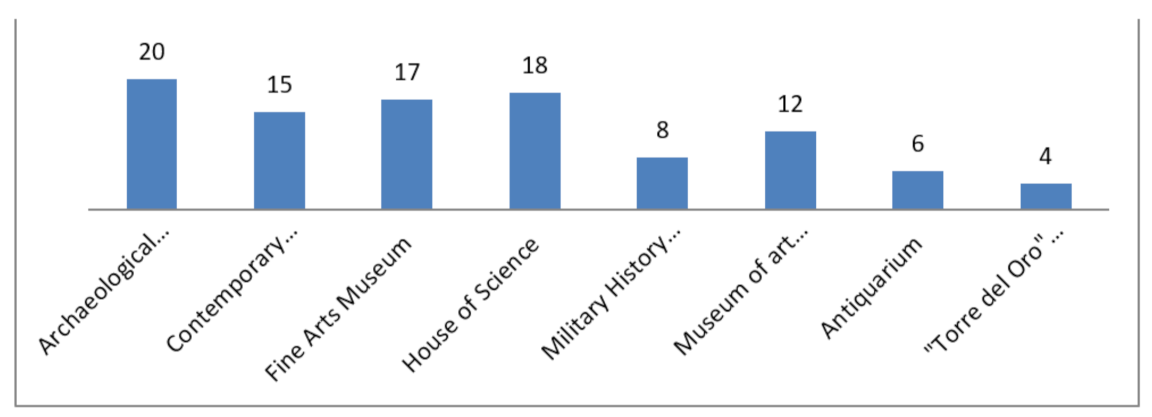

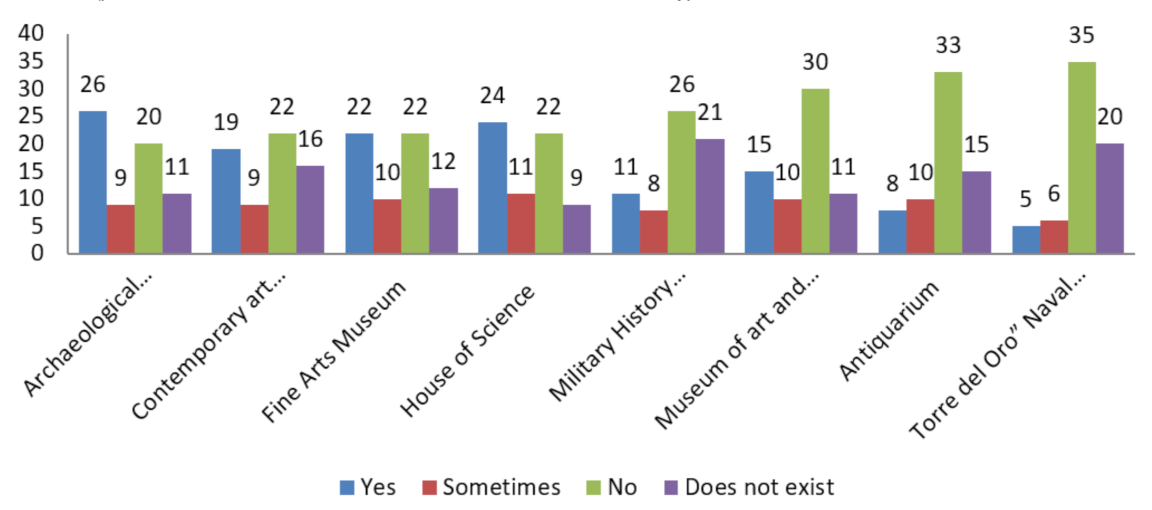

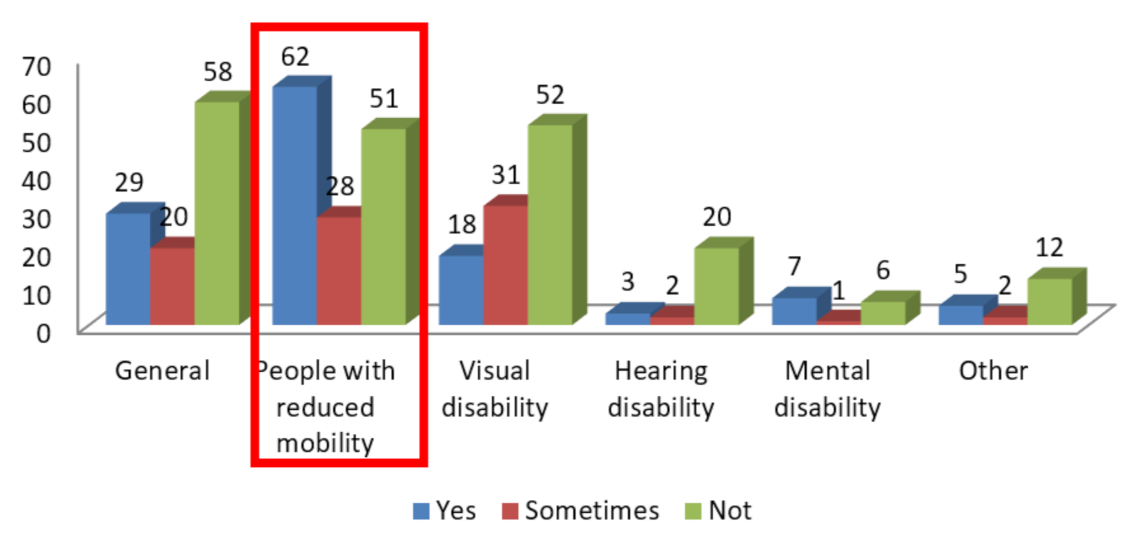

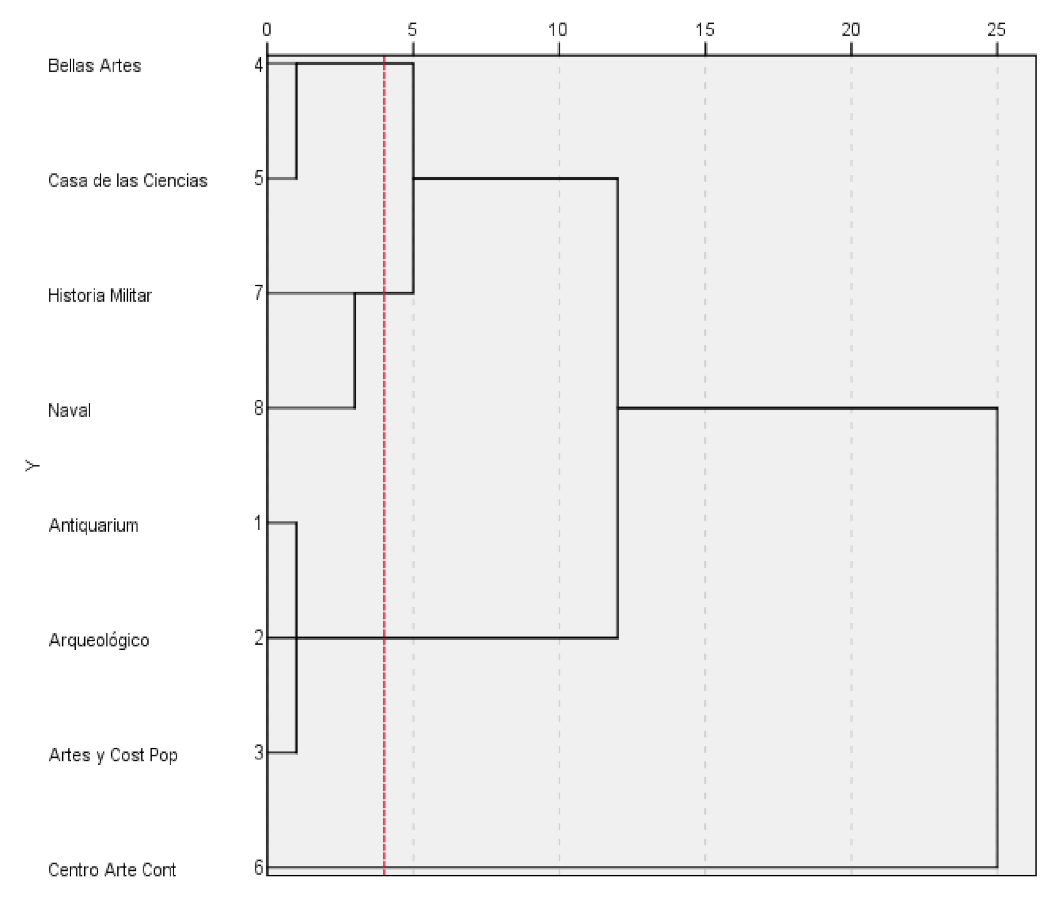
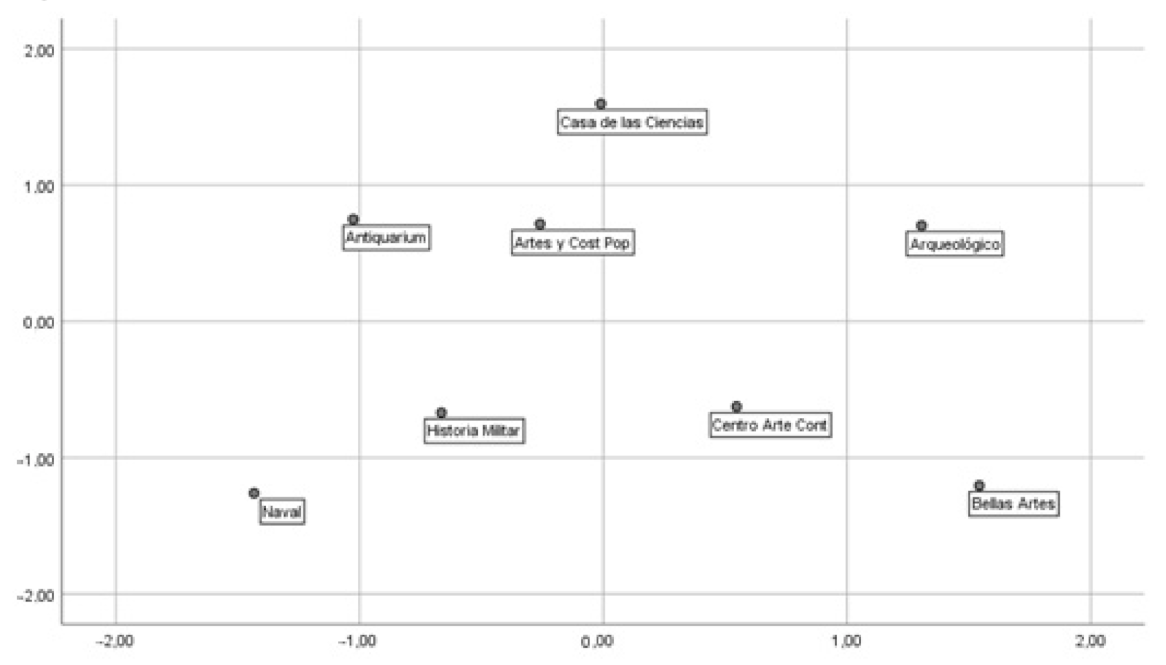


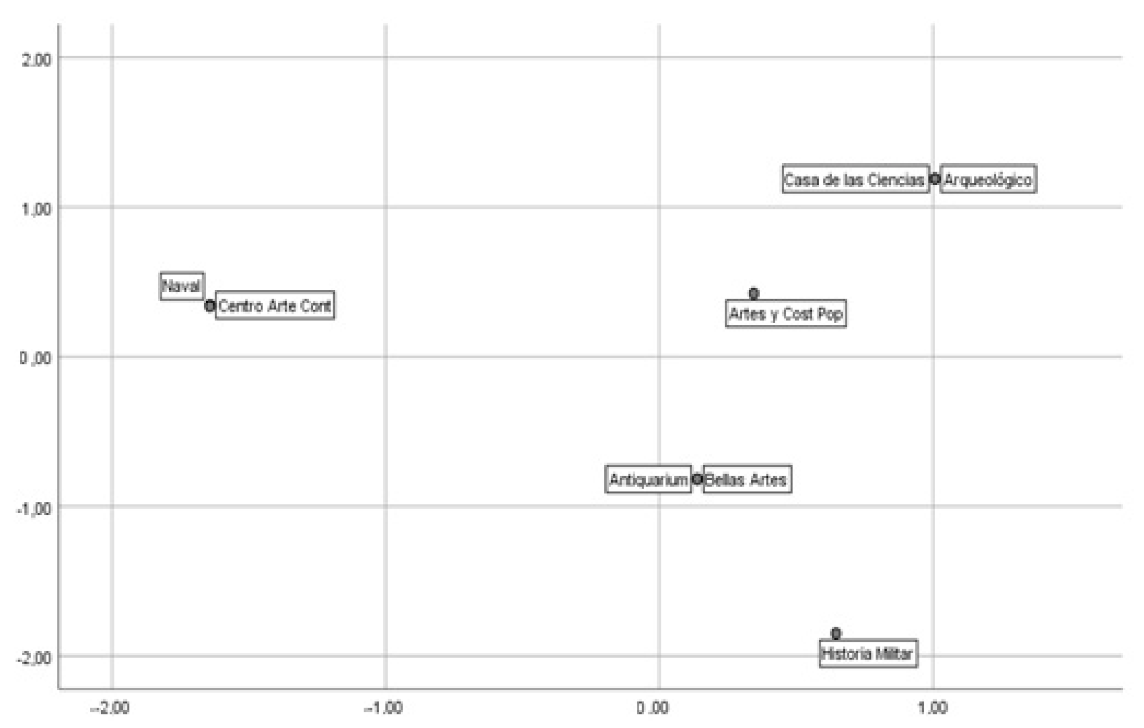
| Authors | Objective | Number of Cases Studied | Methodology Used | Result |
|---|---|---|---|---|
| AEVAL (State Agency for the Evaluation of Public Policies and the Quality of Services) [41] | Evaluation of the accessibility of state-owned museums | 14 | The information used in the evaluation process comes from documentary and organizational sources, user surveys, interviews and the application of direct observation techniques. | The Archaeological museum, Sorolla museum, Casa de Cervantes, and Decorative Arts Museumlack adapted access. The Museum of Anthropology only allows access to the first floor since it lacks elevators. The remaining museums have adapted or alternative access. |
| Generalitat of Catalunya [42] | To determine the levels of accessibility the Catalan tourist industry offers, including accommodation, resources and tourist services. | 18 | Diagnosis of the situation through the “Tourism Accessibility Plan” analysis tool. | Accessible tourism in Catalonia is a tangible reality. |
| Prieto and García [43] | To study the accessibility status of the Museum of Fine Arts in the Principality of Asturias. | 1 | With the information obtained in the assessment of the accessibility of establishments and institutions, a descriptive document of the different spaces studied was created based on the accessibility law of the Principality of Asturias. | The museum does not have an accessible website, no employee knows Spanish sign language, there is no information in Braille, there are no audio guides or sign guides, and there is only one wheelchair available for use in case of need. |
| Reich, Lindgren-Streicher, Beyer, Levent, Pursley, and Mesiti [44] | This study sought to describe the experiences of visitors who are blind or have low vision, who visit art museums. | 7 | Focus groups were chosen as the primary data collection method. | Desire to create accessible programs and museum design that incorporate assistive technologies, tactile opportunities, and safe and clear exhibition and architectural designs.Value the positive feelings gained at museums from being socially involved, intellectually and emotionally stimulated, welcomed, and enabled to explore independently. |
| Fernández Alles [45] | Empirically testing universal accessibility at the Guggenheim Museum. | 1 | Singular contemporary case study of holistic character (single unit of analysis). Exploratory, descriptive and explanatory study. | It was the first organization in the country to receive a UNE certificate accrediting a global accessibility management system and the first company to comply with DALCO requirements, guaranteeing total accessibility for people with reduced mobility. |
| Pérez Alcalde [46] | To analyze spatial accessibility in the Museum of Nature and Man (Tenerife). | 1 | Case study method | The “Museo de la Naturaleza y el Hombre” (Museum of Nature and Man) gives much relevance to universal design and the establishment of appropriate accessibility measures. |
| Urpí, Garro y Domeño [47] | To study accessibility at the University of Navarra Museum. | 1 | Case study through questionnaires and interviews with three people with motor and visual disabilities. | The museum requires a clear economic investment for the acquisition of materials and technological resources, as well as training and continuing education of the professionals involved, from the museum′s management team to the administration and services staff, in order to be able to adapt to people with disabilities. |
| Martínez Carrillo [48] | To determine the degree of universal accessibility and adaptation to people with disabilities, both physical and sensory, of each of the spaces and infrastructures of the Museum of Natural History of Rouen (France) | 1 | Compilation of current legislation related to accessibility and equal rights and non-discrimination of people with disabilities both at the international European level and in France. Secondly, this study compiled a series of technical information sheets on accessibility, which allowed for the collection of both general and specific information on the different infrastructures and facilities of the Museum of Natural History of Rouen. | It does not comply with all the accessibility indicators set out in ISO 21542:2011 Building. Accessibility of the built environment. |
| Molina Hoyo [49] | To validate the role of universal accessibility in museums. The case of COSMOCAIXA in Barcelona. | 1 | Triangulation methodology, and the use of various research techniques (interview, visual methods, survey and observation) provided a holistic and integral vision in the creation of a model of accessibility validation for museums. | The results show a high degree of accessibility for people with physical disabilities or reduced mobility and a medium degree for those with hearing disabilities and intellectual or mental disabilities. The Museum does not have sufficient accessible facilities and services for the visually impaired, blind or low vision. |
| Villarín Díaz [50] | To analyze the level of accessibility of the School and Church of Santa Isabel (Marchena). | 1 | Once all the information had been compiled and analyzed, and both the regulations and the guides or projects had been studied, the current planimetry, and the photographs obtained in each visit were takenas a basis, and a detailed study of all elements that required modification or that needed some type of improvement was commenced. | The School and Church of Santa Isabel lacks an accessibility plan; many elements do not comply or present some deficiency in relation to the accessibility regulations. |
| Flores Roncero [51] | To analyze accessibility in 4 and 5-star tourist accommodations in Seville. | 70 | A thorough literature review on the subject was carried out and a survey was conducted. | The participants consider that the accommodations are accessible for those with reduced mobility, hearing impairment and intellectual disability, but not for those with visual impairment. |
| Martínez Carrillo, M.J. [52] | To assess the degree of accessibility of museums in Caen (France). | 3 | Study of indicators in terms of universal accessibility following the determinations of the International Standard ISO 21542:2011 building construction-accessibility and usability of the built environment. | Museums are not fully universally accessible to all people with disabilities. |
| Pablos y Fontal [53] | To determine the state of accessibility in museums in Spain for people with ASD (autism spectrum disorders). | 141 | Firstly, surveys were carried out as an instrument for collecting information; secondly, the OEPE (Observatory of Heritage Education in Spain) inventory form was filled in; the last instrument used was the questionnaire. | Sixty percent of the museums stated that they did not carry out any inclusive initiative.Only 19.6% of the museums stated that they carried out approaches that responded to a conscious and meditated process of reflection and work in favor of the groups that came to the museum. |
| University Students | Professional Training | High School | Elementary Studies | Total | |
|---|---|---|---|---|---|
| Under 18 years | 0.24% | 0.00% | 1.07% | 0.12% | 1.43% |
| 18–25 years | 21.05% | 0.00% | 0.00% | 0.00% | 21.05% |
| 26–34 years | 31.75% | 0.12% | 1.31% | 0.00% | 33.17% |
| 35–44 years | 17.12% | 0.00% | 0.00% | 0.00% | 17.21% |
| 45–54 years | 14.98% | 0.00% | 0.36% | 0.24% | 15.58% |
| 55–64 years | 9.51% | 1.66% | 0.48% | 0.00% | 11.65% |
| 65 years and older | 0.00% | 0.00% | 0.00% | 0.00% | 0.00% |
| Total | 94.65% | 1.78% | 3.21% | 0.36% | 100.00% |
| Cronbach′s Alpha | Variance Accounted for | |||
|---|---|---|---|---|
| Total (Eigenvalue) | Inertia | % Variance | ||
| 1 | 0.880 | 4.991 | 0.454 | 45.375 |
| 2 | 0.803 | 3.702 | 0.337 | 33.655 |
| Total | 8.693 | 0.790 | ||
| Average | 0.847 | 4.347 | 0.395 | 39.515 |
| ANOVA | ||||||
|---|---|---|---|---|---|---|
| Sum of Squares | Gl | Quadratic Mean | F | Sig. | ||
| Object Scores Dimension 1 | Between groups | 5.024 | 3 | 1.675 | 18.373 | 0.008 |
| Within groups | 0.365 | 4 | 0.091 | |||
| Total | 5.389 | 7 | ||||
| Object Scores Dimension 2 | Between groups | 4.302 | 3 | 1.434 | 16.904 | 0.010 |
| Within groups | 0.339 | 4 | 0.085 | |||
| Total | 4.641 | 7 | ||||
Publisher’s Note: MDPI stays neutral with regard to jurisdictional claims in published maps and institutional affiliations. |
© 2021 by the authors. Licensee MDPI, Basel, Switzerland. This article is an open access article distributed under the terms and conditions of the Creative Commons Attribution (CC BY) license (http://creativecommons.org/licenses/by/4.0/).
Share and Cite
Reyes-García, M.E.; Criado-García, F.; Camúñez-Ruíz, J.A.; Casado-Pérez, M. Accessibility to Cultural Tourism: The Case of the Major Museums in the City of Seville. Sustainability 2021, 13, 3432. https://doi.org/10.3390/su13063432
Reyes-García ME, Criado-García F, Camúñez-Ruíz JA, Casado-Pérez M. Accessibility to Cultural Tourism: The Case of the Major Museums in the City of Seville. Sustainability. 2021; 13(6):3432. https://doi.org/10.3390/su13063432
Chicago/Turabian StyleReyes-García, María Eugenia, Fernando Criado-García, José Antonio Camúñez-Ruíz, and María Casado-Pérez. 2021. "Accessibility to Cultural Tourism: The Case of the Major Museums in the City of Seville" Sustainability 13, no. 6: 3432. https://doi.org/10.3390/su13063432
APA StyleReyes-García, M. E., Criado-García, F., Camúñez-Ruíz, J. A., & Casado-Pérez, M. (2021). Accessibility to Cultural Tourism: The Case of the Major Museums in the City of Seville. Sustainability, 13(6), 3432. https://doi.org/10.3390/su13063432






